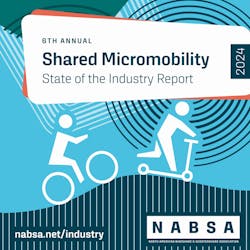NABSA releases 2024 Shared Micromobility State of the Industry Report
The North American Bikeshare and Scootershare Association (NABSA) has released its sixth annual Shared Micromobility State of the Industry Report for North America.
According to NABSA, the 2024 report shows that shared micromobility is both a service that works for people to get where they need to go and is also valued by communities of all sizes across North America. The total number of trips in 2024 increased 31 percent from 2023. At least 225 million trips were taken on shared micromobility in 2024.
The report showed that in 2024, 415 cities across North America had one or more shared micromobility systems, and the total shared micromobility vehicles deployed across North America increased 19 percent from 2023 to 333,000.
“It’s amazing, but not surprising, to see how shared micromobility continues to grow and grow,” said NABSA Executive Director Sam Herr. “It is so clearly providing meaningful service to get people where they need to go and not just in big cities. Smaller and mid-sized cities, rural and suburban communities are all implementing shared micromobility to provide mobility options, improve public transportation and create community vibrancy.”
According to the report, 74 percent of riders say that they use shared micromobility to connect to transit and 35 percent of shared micromobility trips reduce congestion by replacing car trips. The report also showed 46 percent of systems offer adaptive vehicles and that people ride shared micromobility for all kinds of trips, including to get to work, run errands, social activities and dining out and for recreation, which is all contributing to economic vitality in communities.
NABSA says something new in the 2024 report was the capturing of effective shared micromobility parking management strategies being deployed by agencies and operators, as well as a breakdown of public agency funding and staff time support for shared micromobility. The association notes electrification continues to be a major trend, both on the ridership side, as well as operations. In 2024, 79 percent of shared micromobility systems included e-devices and 66 percent of shared micromobility trips were taken on e-devices. E-bike trips reached an all-time high at 64 million trips while e-scooter trips continued to rise, reaching 85 million trips.
The report noted shared micromobility continues to be a solution toward transportation decarbonization. In 2024, shared micromobility across North America offset approximately 101 million pounds of carbon dioxide emissions by replacing car trips.
“Shared micromobility is a sound and good investment for communities of all sizes,” Herr said. “Aligning public funding and policy support with its growing scale and success is key to sustainable operations moving forward. NABSA is currently working toward federal policy priorities in the US that would help to do this.”
NABSA worked with Toole Design and the University of California Berkeley Transportation Sustainability Research Center to help develop the report. The report is composed of survey results, statistics gathered from performance reports released by shared micromobility systems and data from GBFS. In addition to the metrics shared above, more information about year-over-year trends, mode shift, benefits of shared micromobility, equity programs, trip and vehicle trends, system statistics by size, operating characteristics, shared micromobility and transit and more can be found in the report, which can be viewed on NABSA’s website.
